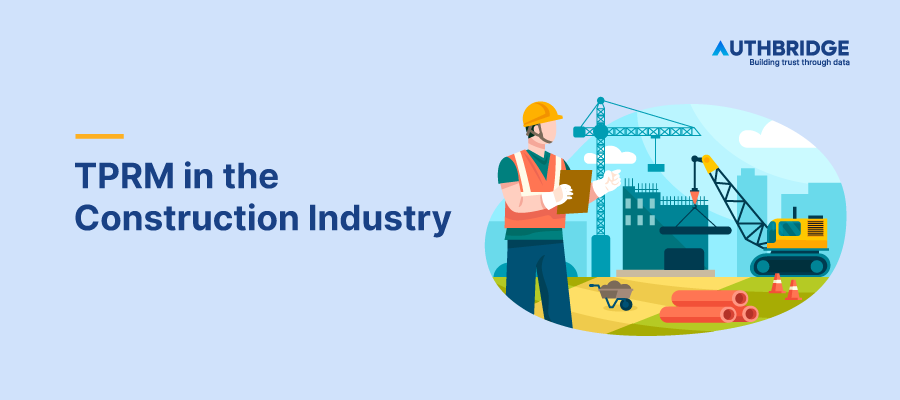Introduction
The construction sector in India, characterized by its dynamic growth and complex project ecosystems, is increasingly recognizing the importance of Third-Party Risk Management (TPRM). Amidst the pressures of timely delivery, budget constraints, and quality standards, the industry faces a multitude of risks, particularly when engaging with subcontractors and managing project safety. This section delves into the criticality of TPRM in navigating the sector’s challenges and ensuring the successful execution of construction projects in India.
The Significance of TPRM in India
India’s construction industry is a cornerstone of its economy, contributing significantly to its GDP and employment. However, the sector is fraught with risks ranging from financial, operational, to regulatory and reputational hazards. Effective TPRM strategies are crucial for construction firms to mitigate these risks, safeguard their projects against unforeseen issues, and ensure compliance with the country’s stringent safety and regulatory requirements.
Overview of Challenges in the Construction Sector
The Indian construction landscape is particularly challenging due to its regulatory complexity, reliance on a vast network of subcontractors, and the inherent safety risks associated with construction activities. From fluctuating material costs and labor shortages to environmental considerations and compliance with local regulations, construction companies must navigate a labyrinth of potential pitfalls. This environment underscores the necessity for a comprehensive TPRM framework that can adapt to the multifaceted nature of construction projects and stakeholder relationships.
Managing Risks with Subcontractors
In the construction industry, subcontractors play a vital role in completing projects on time, within budget, and according to quality standards. However, relying on third parties introduces risks that can affect project outcomes. Here’s how companies can manage these risks effectively.
Assessing Subcontractor Capabilities and Risk Profiles
Before engaging with subcontractors, it’s essential to assess their capabilities and risk profiles thoroughly. This involves evaluating their past project performance, financial stability, adherence to safety and regulatory standards, and their ability to meet project deadlines. Construction firms can use a standardized assessment framework to rate subcontractors on these criteria, ensuring a data-driven selection process.
Key Strategy: Implement a prequalification process for subcontractors that includes checks on their licenses, insurance, financial health, and references. This approach helps in selecting reliable partners who are likely to meet project demands and regulatory requirements.
Implementing Robust Due Diligence Processes
Due diligence is crucial in identifying potential risks associated with subcontractors. This includes legal compliance checks, environmental assessments, and verification of safety records. By conducting thorough due diligence, construction companies can uncover any issues that might pose a risk to project delivery or regulatory compliance.
Practical Tip: Utilize digital platforms and databases to streamline the due diligence process, allowing for efficient tracking of subcontractor compliance and performance history.
Building Effective Communication and Reporting Mechanisms
Effective communication and transparent reporting mechanisms are key to managing subcontractor risks. Regular meetings, clear communication of expectations, and real-time reporting can help identify and mitigate risks early. It’s also important to establish a clear escalation path for any issues that arise.
Ensuring Regulatory Compliance
Navigating the complex regulatory landscape of India’s construction industry is critical for project success. Compliance ensures not only the safety and well-being of workers but also protects companies from legal and financial repercussions.
Navigating India’s Construction Regulations and Standards
India’s construction sector is governed by various national and state-level regulations, including the Building and Other Construction Workers Act, the National Building Code, and environmental regulations. Understanding and adhering to these regulations is essential for any construction project’s success.
Best Practice: Developing a compliance checklist and conducting regular audits against it can help ensure that projects stay on the right side of the law.
Best Practices for Regulatory Compliance Management
Effective compliance management involves more than just meeting the minimum legal requirements. It requires a commitment to ethical practices, environmental stewardship, and community engagement. Establishing a compliance management system that integrates with the overall project management framework can streamline this process.
Expert Opinion: Legal and industry experts emphasize the importance of continuous education and training on regulatory changes, suggesting that staying informed is key to maintaining compliance.
The Impact of Non-Compliance on Projects and Reputation
Non-compliance can lead to project delays, financial penalties, and damage to a company’s reputation. In severe cases, it can also result in project shutdowns. Therefore, investing in compliance is not just a legal necessity but a strategic business decision.
Case Study: A housing project in Pune faced significant delays and financial penalties due to non-compliance with environmental regulations. This case highlights the importance of early and continuous compliance planning in project management.
Expert Opinion: Regulatory Challenges and Solutions in India
Experts point to the fragmented regulatory environment and the rapid pace of regulatory changes as significant challenges in India. They recommend a proactive approach to compliance, leveraging legal expertise, and engaging with regulatory bodies to navigate these challenges effectively.
OnboardX By AuthBridge
Welcome to the Future of Vendor Management, OnboardX: The Comprehensive Platform for end-to-end Third-Party Onboarding and Verification. Say goodbye to the hurdles of inefficiency, data disparities, and regulatory complexities.
Adopt a path of automated processes, scalable operations, and cutting-edge analytics to elevate your vendor relationship management to new heights.
As leaders in the world of BGV and due-diligence, our one stop onboarding solution aims to provide seamless onboarding to organisations by offering features such as:
- Case approval workflow with payment and contract signing
- Custom communication options in emails and WhatsApp
- 160+ real-time checks and verifications
- Personalized and customizable solution
- Seamless API integration
- Fully automated journey with multiple touch points and clear visibility
Why Choose OnboardX?
OnboardX is a comprehensive one-stop solution for all your vendor onboarding needs and here a few reasons why we think it will be the best suited solution for your needs:
- Unmatched Flexibility: A low-code platform allowing fast, custom solution development with minimal technical skill requirements.
- Comprehensive Integration: Deep integration capabilities with major ERP and P2P suites, serving as a central third-party data layer.
- Advanced Third-Party Data Management: Expertise in managing complex and continuously changing third-party data, with more than 18+ years of enterprise experience.
- Targeted Solutions Over Generic Tools: Specific focus on third-party data, differentiating from generic P2P suites, MDM solutions, and in-house systems.
- Pre-Integrated APIs: Comes with pre-integrated APIs and proprietary databases for faster turn-around time and comprehensive verification processes
- Easy on Pockets: Consolidate data collection, verification, and signature processes into a single, budget-friendly solution. Say goodbye to fragmented expenses on multiple tools – OnboardX streamlines it all for the price of one.
- Dedicated Third Party Expertise: Dedicated team focused on vendor management solutions, ensuring specialised knowledge and tailored services.
Conclusion
The path to success in India’s construction industry lies in rigorous risk management, safety innovation, and strict adherence to regulatory standards. By embracing technology, fostering a culture of safety, and staying informed on regulatory changes, companies can not only mitigate risks but also pave the way for sustainable and successful construction practices.






